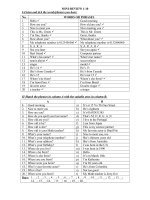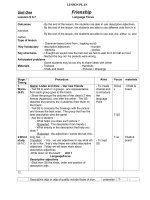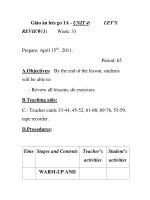Review 1. (1-2-3). Lesson 1. Language
Bạn đang xem bản rút gọn của tài liệu. Xem và tải ngay bản đầy đủ của tài liệu tại đây (117.67 KB, 5 trang )
<span class='text_page_counter'>(1)</span><div class='page_container' data-page=1>
Week: Date of planning: 15 / 09 / 2015
Period: 23,24 Date of teaching: / /
<b>REVIEW 1</b>
<b>I. Objectives:</b>
By the end of this lesson, students can revise the language they have studied and the
skills they have practiced since Unit 1.
<b>II. Language Focus:</b>
<i>1. Vocabulary: revise the vocabulary they have learnt since Unit 1.</i>
<i>2. Structures:</i> The present simple and the present continuous tense.
There is / There isn’t - There are / There aren’t.
Prepositions of place.
Verbs be and have for descriptions.
The Present Continuous for future.
<b>III. Method: Communicative approach</b>
<b>IV. Teaching aids: Course book, CD player, pictures.</b>
<b>V. Procedures:</b>
<b>STAGES</b> <b>TEACHER AND STUDENTS’</b>
<b>ACTIVITIES</b>
<b>CONTENTS</b>
Presentation
- Elicit the rules of pronouncing the
final –s/-es if needed.
- Ask Ss to do the exercise
individually.
- Organize this as a game. Ask Ss to
do this in pairs. The pairs that find
the most words will go to the board
and write the answers.
- Have Ss do this exercise
individually and then share their
answers with a partner.
- Check Ss’ answers.
- Ask Ss to do in pairs. This can be
done as a small competition.
Pronunciation
<i>1. Odd one out. Which underlined </i>
<i>part is pronounced differently in each</i>
<i>line?</i>
Key:
1. D 2. C 3. C 4. A 5. B
<i>2. Write the name of the school things</i>
<i>and furniture in the house which </i>
<i>begin with /b/ and /p/.</i>
Key:
<b>/b/</b> <b>/p/</b>
Book, bag,
bed…
Pen, pencil,
picture,
poster…
Vocabulary
<i>3. Complete the words.</i>
<i>Key:</i>
</div>
<span class='text_page_counter'>(2)</span><div class='page_container' data-page=2>
<i>4. Do the crossword puzzle.</i>
<i><b>Across: </b></i>
1. Wardrobe 3. Living room
5. apartment 6. Poster
<i><b>Down: 2. Dining room 4. hall</b></i>
<i>2. Make your own Haiku.</i>
<i>Write a three line Haiku poem to </i>
<i>describe yourself.</i>
Practice
- Quickly check Ss’ answers. If time
allows, ask Ss to think of some other
words and make sentences.
- Elicit the use of the present and the
present continuous. Call one st do
this exercise on the board. Other Ss
also do this.
- Check Ss’ answers.
- Ask them for explanation.
- Ask Ss to read the text carefully
and pay attention to the hints. Ask Ss
to do this individually and compare
their answers with a partner.
- Check Ss’ answer and ask them to
explain the negative forms in their
answers.
- At the same time, ask one pair to
<i>5. Choose the correct words.</i>
<i>Key: </i>
<i> 1. quite 2. Shy 3. Hard-working</i>
<i> 4. patient 5. Sporty</i>
Grammar
<i>6. Complete the sentences with the </i>
<i>present simple or the present </i>
<i>continuous form of this verbs in </i>
<i>brackets.</i>
Key:
1. is raining
2. do you have
3. am not going out ; am doing
4. likes; is sleeping
5. is
<i>7. Complete the description with the </i>
<i>correct form of the verbs “be” or </i>
<i>“have”.</i>
Key:
1. is 2. isn’t 3. doesn’t have
4. is 5. has 6. are 7. is 8. Is
</div>
<span class='text_page_counter'>(3)</span><div class='page_container' data-page=3>
go to the board and does this
exercise.
- Check Ss’ answers.
- Ask Ss to do this in pair. After
checking their answers, ask one or
two pairs to act out the conversation.
- Ask Ss to do this exercise
individually and check their answers
with a partner before giving their
answers to the T to confirm the
correct answers.
- Have Ss work in groups. One
interviews the other two what they
like and dislike about the school and
the reason why.
- Summaries Ss’ ideas.
- Play the recording once for Ss to
listen. Play the recording again for
Ss to check their answers. Announce
the answer to Ss.
- Ask Ss to quickly read the
questions. Ask Ss to listen to the
recording again and answer the
questions.
<i>furniture in the right place.</i>
Everyday English
<i>9. Number the lines of the dialogue in</i>
<i>the correct order.</i>
Key:
6 – 1 – 7 – 2 – 3 – 5 – 8 – 4
Reading
<i>1. Choose A, B or C for each blank in</i>
<i>the e-mail.</i>
Key:
1. A 2. C 3. C 4. B 5. A 6. B
2. Read the text and answer the
questions.
Key:
1. It’s in a quiet place not for from
the city center.
2. They are hard-working and
serious.
3. They are helpful and friendly.
4. There are five clubs.
5. Because it’s a good school.
Speaking
<i>3. Interview two classmates. Ask them</i>
<i>what they like and dislike about your </i>
<i>school and the reasons why. </i>
Listening
<i>4. An and Mi are talking on the </i>
<i>phone. Listen and circle the parts of </i>
<i>the house you hear.</i>
Key:
</div>
<span class='text_page_counter'>(4)</span><div class='page_container' data-page=4>
- Ask Ss to compare their answers
before giving T their answers.
Key:
1. She’s watering the plants n the
garden.
2. He’s listening to the radio.
3. He’s in Mi’s bedroom.
4. She’s watching TV.
Production - Elicit the parts of an e-mail.
- Ask Ss to work in groups to do this
exercise.
Writing
<i>6. Write an e-mail to your friend. Tell</i>
<i>him/ her about a family member. </i>
Homework
<sub>- Write the e-mail in your notebook.</sub>
- Prepare the next lesson: the 1<b>st<sub> 45 </sub></b>
<b>minutes test.</b>
<b>VI. Comments</b>
</div>
<span class='text_page_counter'>(5)</span><div class='page_container' data-page=5></div>
<!--links-->









